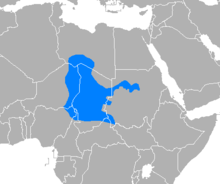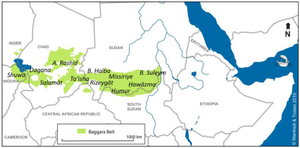lingvo.wikisort.org - Language
Chadian Arabic (Arabic: لهجة تشادية), also known as Shuwa Arabic,[lower-alpha 1] Baggara Arabic, Western Sudanic Arabic, or West Sudanic Arabic (WSA),[2] is a variety of Arabic and the first language of 1.6 million people,[3] both town dwellers and nomadic cattle herders. The majority of its speakers live in southern Chad. Its range is an east-to-west oval in the Sahel. Nearly all of this territory is within Chad or Sudan. It is also spoken elsewhere in the vicinity of Lake Chad in the countries of Cameroon, Nigeria, Niger. Finally, it is spoken in slivers of the Central African Republic, and South Sudan. In addition, this language serves as a lingua franca in much of the region. In most of its range, it is one of several local languages and often not among the major ones.
| Chadian Arabic | |
|---|---|
| Shuwa | |
| لهجة تشادية | |
| Native to | Chad, Central African Republic, Cameroon, Sudan, South Sudan, Nigeria, Niger |
Native speakers | 1.6 million (2015)[1] |
Language family | Afro-Asiatic
|
Writing system | Arabic alphabet |
| Language codes | |
| ISO 639-3 | shu |
| Glottolog | chad1249 |
 | |
Name and origin
This language does not have a native name shared by all its speakers, beyond "Arabic". It arose as the native language of nomadic cattle herders (baggāra, Standard Arabic baqqāra بَقَّارَة, means 'cattlemen', from baqar[4]). Since the publication of a grammar of a Nigerian dialect in 1920,[5] this language has become widely cited academically as "Shuwa Arabic"; however, the term "Shuwa" was in use only among non-Arab people in Borno State, Nigeria. Around 2000, the term "Western Sudanic Arabic" was proposed by a specialist in the language, Jonathan Owens.[6] The geographical sense of "Sudanic" invoked by Owens is not the modern country of Sudan, but the Sahel in general, a region dubbed bilad al-sudan, 'the land of the blacks', by Arabs as far back as the medieval era. In the era of British colonialism in Africa, colonial administrators too used "the Sudan" to mean the entire Sahel.
How this Arabic language arose is unknown. In 1994, Braukämper proposed that it arose in Chad starting in 1635 by the fusion of a population of Arabic speakers with a population of Fulani nomads.[7] [4] (The Fulani are a people, or group of peoples, who originate at or near the Atlantic coast but have expanded into most of the Sahel over centuries.)
During the colonial era, a form of pidgin Arabic known as Turku[8] was used as a lingua franca. There are still Arabic pidgins in Chad today, but since they have not been described, it is not known if they descend from Turku.[9]
Distribution

The majority of speakers live in southern Chad between 10 and 14 degrees north latitude. In Chad, it is the local language of the national capital, N'Djamena, and its range encompasses such other major cities as Abéché, Am Timan, and Mao. It is the native language of 12% of Chadians. Chadian Arabic's associated lingua franca[10] is widely spoken in Chad, so that Chadian Arabic and its lingua franca combined are spoken by somewhere between 40% and 60% of the Chadian population.[11][12]
In Sudan, it is spoken in the southwest, in southern Kurdufan and southern Darfur, but excluding the cities of al-Ubayyid and al-Fashir. Its range in other African countries includes a sliver of the Central African Republic, the northern half of its Vakaga Prefecture, which is adjacent to Chad and Sudan; a sliver of South Sudan at its border with Sudan; and the environs of Lake Chad spanning three other countries, namely part of Nigeria's (Borno State), Cameroon's Far North Region, and in the Diffa Department of Niger's Diffa Region. The number of speakers in Niger is estimated to be 150,000 people.
In Nigeria, it spoken by 10% of the population of Maiduguri, the capital of Borno,[13] and by at least 100,000 villagers elsewhere in Borno.
Early 20th century scholarship
In 1913, a French colonial administrator in Chad, Henri Carbou, wrote a grammar of the local dialect of the Ouaddaï highlands, a region of eastern Chad on the border with Sudan.[14] In 1920, a British colonial administrator in Nigeria, Gordon James Lethem, wrote a grammar of the Borno dialect, in which he noted that the same language was spoken in Kanem (in western Chad) and Ouaddaï (in eastern Chad).[15]
Phonetics
It is characterized by the loss of the pharyngeals [ħ] and [ʕ], the interdental fricatives [ð], [θ] and [ðˤ], and diphthongs.[16][17] But it also has /lˤ/, /rˤ/ and /mˤ/ as extra phonemic emphatics. Some examples of minimal pairs for such emphatics are /ɡallab/ "he galloped", /ɡalˤlˤab/ "he got angry"; /karra/ "he tore", /karˤrˤa/ "he dragged"; /amm/ "uncle", /amˤmˤ/ "mother".[16] In addition, Nigerian Arabic has the feature of inserting an /a/ after gutturals (ʔ,h,x,q).[16] Another notable feature is the change of Standard Arabic Form V from tafaʕʕal(a) to alfaʕʕal; for example, the word taʔallam(a) becomes alʔallam. The first person singular perfect tense of verbs is different from its formation in other Arabic dialects in that it does not have a final t. Thus, the first person singular of the verb katab is katáb, with stress on the second syllable of the word, whereas the third-person singular is kátab, with stress on the first syllable.[16]
The following is a sample vocabulary:
| word | meaning | notes |
|---|---|---|
| anīna | we | |
| 'alme | water | frozen definite article 'al |
| īd | hand | |
| īd | festival | |
| jidãda, jidãd | chicken, (collective) chicken | |
| šumāl | north |
The two meanings of īd stem from formerly different words: *ʔīd "hand" < Classical yad vs. *ʕīd "festival" < Classical ʕīd.
In Classical Arabic, chicken (singular) is dajaja, and collectively dajaj.
See also
- Languages of Chad
- Languages of Cameroon
- Varieties of Arabic
Notes
- The term "Shuwa Arabic" in a strict meaning only refers to the Nigerian dialects of this particular language, but is not used by those speakers themselves.
- Chadian Arabic at Ethnologue (20th ed., 2017)
- Manfredi, Stefano; Roset, Caroline (September 2021). "Towards a Dialect History of the Baggara Belt". Languages. 6 (3): 146. doi:10.3390/languages6030146. ISSN 2226-471X.
- Ethnologue, Chad, entry for Arabic, Chadian Spoken
- Watson 1996, p. 359.
- Gordon James Lethem, Colloquial Arabic: Shuwa dialect of Bornu, Nigeria and of the region of Lake Chad: grammar and vocabulary, with some proverbs and songs, Published for the Government of Nigeria by the Crown Agents for the Colonies
- Owens 2003
- Owens 1993
- Hammarström, Harald; Forkel, Robert; Haspelmath, Martin, eds. (2017). "Turku". Glottolog 3.0. Jena, Germany: Max Planck Institute for the Science of Human History.
- Thomason, Sarah Grey (January 1997). Contact Languages: A Wider Perspective. ISBN 9027252394.
- In French, the term for lingua franca is langue véhiculaire
- Pommerol 1997, pp. 5, 8.
- Pommerol 1999, p. 7.
- Owens 2007.
- Carbou 1954.
- Kaye 1976, p. 95.
- Owens 2006.
- Kaye 1987.
References
- Carbou, Henri (1954) [1913]. Méthode pratique pour l'étude de l'arabe parlé au Ouaday et à l'est du Tchad [Practical method for studying the Arabic spoken in Waddai and the east of Chad]. Paris: Librairie orientaliste Geuthner. The 1954 printing contains the 1913 edition, including the original title page.
- Fox, Andrew (October 1988). "Nigerian Arabic–English Dictionary by Alan S. Kaye, Book Review". Language. Language, Vol. 64, No. 4. 64 (4): 836. doi:10.2307/414603. JSTOR 414603.
- Kaye, Alan S. (1976). Chadian And Sudanese Arabic In The Light Of Comparative Arabic Dialectology. Mouton.
- Kaye, Alan S. (1987). Nigerian Arabic-English dictionary. Bibliotheca Afroasiatica. Vol. 2. Malibu: Undena.
- Owens, Jonathan (2007). "Close Encounters of a Different Kind: Two types of insertion in Nigerian Arabic code switching". In Miller, Catherine G. (ed.). Arabic in the city: issues in dialect contact and language variation. London: Routledge. ISBN 978-0-415-77311-9.
- Owens, Jonathan (2003). "Arabic dialect history and historical linguistic mythology". Journal of the American Oriental Society. 123 (4): 715–740. doi:10.2307/3589965. JSTOR 3589965.
- Owens, Jonathan (2006). A Linguistic History of Arabic. Oxford University Press.
- Pommerol, Patrice Jullien de. (1997). L'arabe tchadien: émergence d'une langue véhiculaire. Karthala. ISBN 9782865378043. 174 pp.
- Pommerol, Patrice Jullien de. (1999). Grammaire pratique de l'arabe tchadien. Karthala. ISBN 9782865379385. 280 pp. N'Djamena dialect.
- Watson, J. C. E. (1996). "Review of Owens 1994". Bulletin of Oriental and African Studies. 59: 359–360. doi:10.1017/S0041977X00031797. S2CID 162441223.
Further reading
- Howard, Charles G. 1921. Shuwa Arabic Stories with an Introduction and Vocabulary Oxford: University Press, 1921, 114 pp.
- Kaye, Alan S. 1982. Dictionary of Nigerian Arabic. Malibu: Undena. Series: Bibliotheca Afroasiatica; 1. This volume is English-Arabic. 90 pp.
- Owens, Jonathan. 1993. A grammar of Nigerian Arabic. Wiesbaden: Otto Harrassowitz.
- Owens, Jonathan, ed. 1994. Arabs and Arabic in the Lake Chad Region. Rüdiger Köppe Verlag. Series: SUGIA (Sprache und Geschichte in Afrika); 14.
- Pommerol, Patrice Jullien de. 1999. J'apprends l'arabe tchadien. Karthala. 328 pp. N'Djamena dialect.
- Rumford, James, Rumford, Carol. 2020. Chadian Arabic, L'Arabe Tchadien. Manoa Press. 122 pp.
- Woidich, Manfred. 1988. [Review of Kaye 1987] . Journal of the American Oriental Society, October - December 1988, 108(4): 663-665
External links
- Chadian Arabic videos Archived 2018-01-18 at the Wayback Machine
На других языках
[de] Tschadisch-Arabisch
Tschadisch-Arabisch, auch Tschadarabisch, oder Schuwa-Arabisch, auch Arabe Choa, Shuwa Arabic, l’arabe du Tchad, Baggara-Arabisch, ist eine Varietät des Arabischen, die in der Region des Tschadbeckens von den Schua-Arabern gesprochen wird. Sie wird mit dem arabischen Alphabet geschrieben.- [en] Chadian Arabic
[es] Árabe chadiano
El árabe chadiano es un dialecto del árabe que se habla principalmente en Chad, pero también en Camerún, República Centroafricana, Níger y Nigeria.[fr] Arabe tchadien
L'arabe tchadien, appelé aussi Kalam arabe, est la variété dialectale de la langue arabe parlée au Tchad, au Cameroun, au Nigéria, au Niger et au Soudan. Elle est la langue maternelle de plus de 40% de la population tchadienne. Elle joue également le rôle de lingua franca dans la région.[ru] Чадский диалект арабского языка
Чадский (шоа, шува) диалект арабского языка (араб. اللهجة التشادية) — одна из разновидностей арабского языка, распространённая среди арабов-шоа (баггара) и относящаяся к периферийным диалектам восточной группы диалектов[1]. Чадский диалект распространён на территории центральноафриканского государства Чад, а также в приграничных странах: Камеруне (крайний север), Нигере (регион Диффа) и Нигерии (штат Борно). Общее число носителей — 1 млн 633 тыс. человек, из них: 1 млн 320 тыс. в Чаде (2013), 75 тыс. в Камеруне (2005), 100 тыс. в Нигерии (1973) и 5 тыс. в Нигере (1998)[2].Другой контент может иметь иную лицензию. Перед использованием материалов сайта WikiSort.org внимательно изучите правила лицензирования конкретных элементов наполнения сайта.
WikiSort.org - проект по пересортировке и дополнению контента Википедии